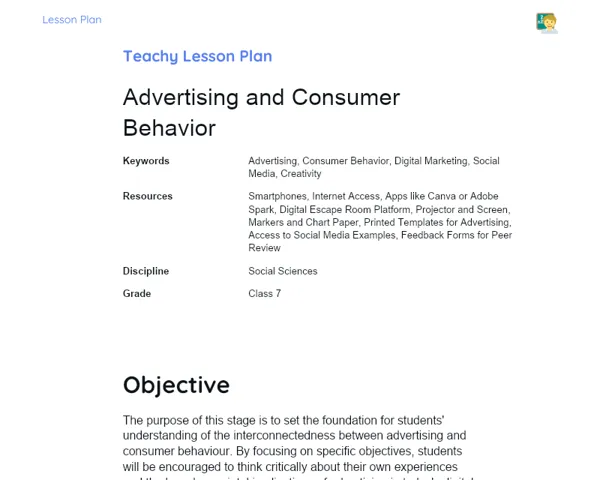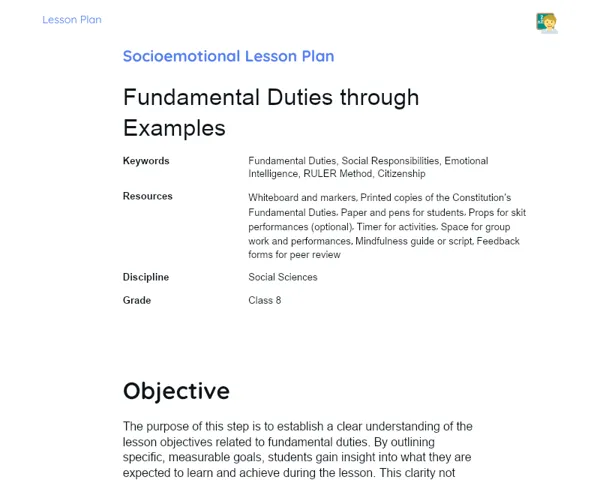Lesson Plan | Teachy's Iteractive Lesson Plan | Economic Changes in Colonial India
| Keywords | Economic Changes, Colonial India, British Policies, Local Industries, Digital Methodology, Active Learning, Critical Thinking, Teamwork, Digital Storytelling, Debate, Trade Simulation, Contemporary Relevance, Group Discussion, Feedback, Student Engagement |
| Resources | Smartphones or Tablets, Computers with Internet Access, Digital Storytelling Tools (e.g., Canva), Presentation Platforms (e.g., Padlet, Google Slides), Historical Images and Documents, Art Supplies for Posters, Digital Collaboration Tools (e.g., Zoom, Google Meet), Printed Worksheets for Group Activities, Projector for Presentations |
| Codes | - |
| Grade | Class 5 |
| Discipline | Social Sciences |
Objectives
Duration: 10 - 15 minutes
The purpose of this stage of the lesson plan is to lay a solid foundation for students to engage with the complex economic changes that occurred in Colonial India. By clearly outlining the main and side objectives, students will be directed towards critical thinking and analysis, empowering them to become the protagonists of their own learning journey. This stage aims to connect the historical context of economic changes to their present-day experiences, allowing them to engage actively with the material.
Main Objectives:
1. Identify and explain the key economic changes in India during the colonial period, emphasizing the impact of British policies on local industries.
2. Analyze various economic reports and documents from the colonial era to understand their significance in shaping the modern Indian economy.
Secondary Objectives:
- Develop critical thinking skills by comparing historical economic conditions with contemporary economic situations in India.
- Foster teamwork and collaboration by engaging in group discussions and activities.
Introduction
Duration: 10 - 15 minutes
The purpose of this warm-up stage is to stimulate students' interest and set the tone for a deep exploration of economic changes that occurred during Colonial India. By searching for interesting facts, students will actively engage with the material, priming their minds for discussion and analysis. This initial inquiry fosters a sense of ownership over their learning, allowing students to connect historical events with the dynamics of today's world, thus enhancing their critical thinking and making the subject matter relatable.
Warming Up
To kick off the lesson on Economic Changes in Colonial India, instruct the students to take out their smartphones and search for an interesting fact about the economic situation in India during the colonial era. This activity will not only warm them up for the topic but also encourage them to engage with digital resources, blending the past with their present-day digital habits. This exercise is designed to connect their curiosity with historical events, making the lesson feel relevant and exciting.
Initial Thoughts
1. What were some of the major economic changes during colonial rule in India?
2. How did British policies affect local industries and farmers?
3. Can you identify any lasting effects of colonial economic policies on modern India?
4. In what ways do you think the historical economic changes impact our everyday lives today?
5. How do the economic conditions of colonial India compare to current economic challenges?
Development
Duration: 70 minutes
The purpose of this stage of the lesson plan is to engage students through innovative and interactive activities that connect historical economic changes in Colonial India to their contemporary understanding. By involving technology and collaborative methods, students will deepen their comprehension of the topic, enhance critical thinking, and develop valuable skills such as creativity, communication, and teamwork. Each activity is designed to foster an immersive learning experience, allowing students to take ownership of their narratives and analyses.
Activity Suggestions
Activity Recommendations
Activity 1 - Colonial India Insta-Story Challenge
> Duration: 60 - 70 minutes
- Goal: To understand the economic changes during Colonial India by relating historical events to personal narratives and enhance digital storytelling skills.
- Activity Description: In this activity, students will create an Instagram story that narrates a day in the life of a farmer or local artisan in Colonial India. They will utilize images, short videos, and text to showcase the impacts of British economic policies on their character. Students can use historical images, contemporary visuals, and digital storytelling tools to enrich their stories, making them as engaging and realistic as possible. This activity promotes creativity and a deep understanding of the historical context.
- Instructions:
-
- Divide students into groups of up to 5 members.
-
- Each group will choose a character - either a farmer or a local artisan - from Colonial India.
-
- Research the chosen character’s daily life during the colonial period, focusing on how economic changes affected their work and livelihood.
-
- Each group will create a storyboard outlining key moments to include in their Instagram story.
-
- Use smartphones or computers to create the Instagram story using digital tools (like Canva or Instagram's story feature) that include visuals, text, music, and effects.
-
- Present the created stories to the class, explaining the economic changes their characters faced.
Activity 2 - Economic Debate Showdown: Colonial Edition
> Duration: 60 - 70 minutes
- Goal: To critically analyze the impacts of colonial economic changes and develop persuasive communication skills through structured debate.
- Activity Description: In this interactive debate, students will be divided into two teams representing different viewpoints on British economic policies during Colonial India. Using their research, students will prepare arguments either supporting or opposing the changes that occurred in local economies. This activity not only helps enhance analytical and public speaking skills but also encourages collaboration and critical thinking.
- Instructions:
-
- Organize students into two teams: 'Supporters of British Policies' and 'Opponents of British Policies'.
-
- Each team will conduct a brief research session on the impacts of British economic policies on local industries and agriculture.
-
- Teams will draft arguments and counterarguments to prepare for the debate.
-
- Use a digital platform (like Zoom or Google Meet) or physical space to arrange the debate.
-
- Each team will present their arguments and rebuttals, followed by a Q&A session with the audience.
-
- Conclude the debate with reflections on how their views have changed based on the discussions.
Activity 3 - The Virtual Market: Trade Simulation
> Duration: 60 - 70 minutes
- Goal: To experience the economic interactions of Colonial India and understand the impact of colonial policies on various industries through interactive simulation.
- Activity Description: In this gamified activity, students will simulate a marketplace representing various trades and commodities in Colonial India. Each group will represent a specific industry impacted by colonial policies (such as textiles, agriculture, or spices) and will create a digital poster that represents their industry. They will then trade their goods with other groups, echoing the economic exchanges of the time. This engaging simulation helps students visualize economic changes and their ramifications in a fun and interactive way.
- Instructions:
-
- Divide students into groups of 5 and assign each group an industry affected by colonial policies.
-
- Research the assigned industry, focusing on how British policy influenced its production and trade.
-
- Each group will create a digital poster outlining their industry, including illustrations, key facts, and historical impacts.
-
- Set up a virtual trading environment using platforms like Padlet or Google Slides, where each group presents their poster.
-
- Groups will engage in a trading simulation where they can 'trade' their industry goods with other groups while discussing the effects of colonial trade on their industries.
-
- Reflect on the trading experience and how it mirrors historical economic conditions.
Feedback
Duration: 15 - 20 minutes
The purpose of this stage is to consolidate learning through group discussion and feedback. This will allow students to articulate their understanding of Economic Changes in Colonial India, share insights from their collaborative activities, and engage in a reflective practice that deepens their comprehension. By providing and receiving feedback, students will also develop their communication skills and learn the value of constructive criticism, fostering a supportive learning environment.
Group Discussion
To wrap up our exciting exploration of Economic Changes in Colonial India, I would like each group to share their insights and key learnings from today's activities. Reflect on the journey your character took, the debates you had, and the trading experiences you shared. What stood out to you? What surprised you? Let’s hear your thoughts, and remember to respect each other’s opinions as we discuss.
Reflections
1. What was the most striking economic change you discovered during your activities today? 2. How did your character's experience during colonial times reflect the real impact of British policies on the economy? 3. In what ways do you think understanding these historical economic changes is essential for our current economic situation?
360º Feedback
As we conclude, I encourage each of you to give constructive feedback to your group members. Highlight what you found valuable in their presentations and activities, and share one suggestion for improvement. Remember, the goal is to support each other’s learning experiences and grow together as a team. Let's make sure our feedback is thoughtful and respectful!
Conclusion
Duration: 10 - 15 minutes
The purpose of this conclusion stage is to consolidate the students' knowledge gained throughout the lesson, encouraging them to see the bigger picture and the relevance of historical economic changes in their everyday lives. By connecting the lesson content to the contemporary world, students will develop a deeper appreciation for history's impact on current economic realities and their role within them.
Summary
🎉 Economic Changes in Colonial India has been quite an adventure! Students journeyed through time, exploring the lives of farmers and artisans, engaged in lively debates, and participated in vibrant trade simulations. They learned how British policies twisted and turned local economies, impacting everything from textiles to agriculture. With creativity and digital tools, they painted a picture of colonial life that connected their character's struggles to the impactful historical changes! 🤩📚
World
Linking the past to the present, today's exploration of Colonial India's economic landscape helps students understand how historical policies shape modern economic conditions. As they navigate through social media and digital spaces, they can reflect on how these economic dynamics echo in the current global economy, influencing local businesses, trade practices, and even their own shopping habits today! 🌍💼
Applications
Understanding the economic changes during colonial times is crucial for today's world as it offers insights into our current economic challenges. Students can see parallels in today's market dynamics, local industry policies, and even in their own lives as consumers. Recognising historical impacts empowers them to critically analyze modern economic situations and make informed decisions in their communities. 📈🙌



